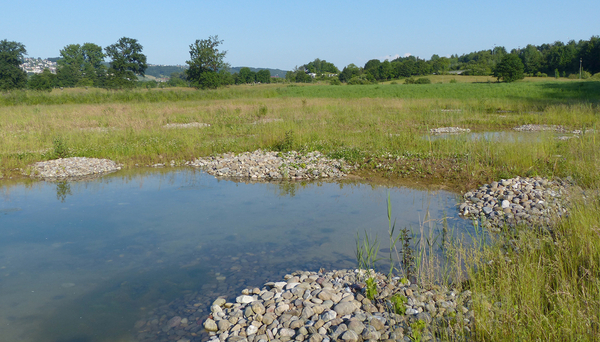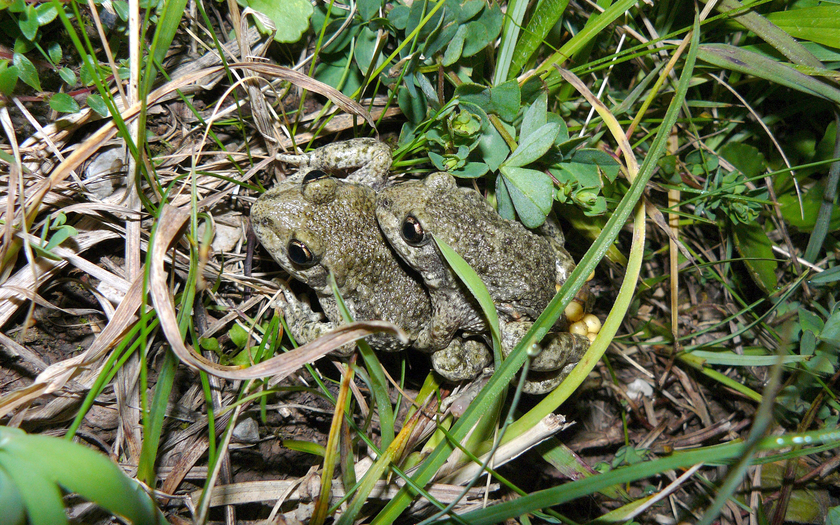News Detail
Four ponds, 100 square metres, diverse and fluctuating: where amphibians feel at home
May 16, 2024 |
How many ponds should we create? What should they look like? And where is a good location? These are the questions most frequently asked by nature conservation experts when it comes to protecting amphibians. “At last, we have concrete recommendations,” says Helen Moor, biologist and head of the Eawag Ecological Modelling research group. As part of the Blue-Green Biodiversity research initiative, she worked with researchers from the aquatic research institute Eawag, the Swiss Federal Research Institute for Forest, Snow and Landscape (WSL) and the Swiss fauna information centre info fauna karch to find simple parameters and specific recommendations to provide practitioners with useful aids for planning and building new ecological infrastructures by constructing natural ponds.
Two to four occupied ponds per square kilometre
“If you are looking for a site for a new pond, two to four ponds or wetlands should already exist within a radius of around 560 metres and should be colonised by the species you want to promote,” says Helen Moor, summarising the recommendations. “Then there is a very good chance that the desired amphibians will migrate to the new pond and accept it as a habitat in the long term.”
At least 100 square metres of water surface and occasional drying out
“New ponds or wetlands should have a water surface of at least 100 square metres. This will make them good spawning grounds for most amphibians,” adds Helen Moor. This could be a larger pond, or preferably several small ponds close to each other. However, individual needs may differ from this general recommendation. “Our problem child, the natterjack toad, which has become very rare in Switzerland, feels particularly at home in amphibian spawning grounds if there are more than 1,000 square metres available.” It would be helpful for this endangered toad species to have areas that experience repeated, extensive flooding, but also dry out again in summer.
Ponds that occasionally dry out are favourable for many amphibians, as predators such as dragonfly larvae or fish do not survive there. “New ponds should be constructed in such a way that the water level fluctuates and sometimes drops to zero,” says Helen Moor. Where natural groundwater fluctuations do not allow this, drainage systems can be installed in a pond, for example.
Open, partly wooded surroundings
“The surroundings of the new ponds should be open and no more than about 50-percent wooded,” adds Helen Moor as a further criterion. On the one hand, woodlands are important habitats for amphibians once they have left the water. On the other hand, individual species such as the midwife toad need sunny embankments with sandy, diggable soil, piles of stones or dry stone walls near the water. This toad species mates on land in a warm and humid burrow built by the male. The males then wrap the eggs around their hind legs and only carry them to the water when they have matured. The tadpoles hatch a short time after contact with the water. A diverse landscape in the vicinity of the wetlands is therefore ideal for life between water and land.
No goldfish, please!
“We want to support the practice of promoting the diversity of amphibian species with specific recommendations for the construction of ecological infrastructures such as networks of ponds,” says Helen Moor. Creating new blue-green habitats is a very effective way of doing something good for local biodiversity as a whole. Other animals and plants also benefit from the water, whether as a source of water and food, as a refuge or as a habitat.
Small bodies of water are also relatively easy to construct and can be integrated into intensively used landscapes with little effort. “Similar to hedges, ponds can easily be added to the edge of farmland,” says Helen Moor. “Or in urban areas in parks and gardens. But no goldfish in the pond, please! They love frogspawn and just eat everything in the water.”
It is also important for local biodiversity to build as many different types of pond as possible, both permanent and temporary, of different sizes and in different surroundings. A diverse landscape promotes a diverse composition of species and, not least, diverse ecosystem functions for both humans and the environment.
Data basis for the study
The basis for the study was the long-term data series of a monitoring programme of the Canton of Aargau, which has been overseeing the construction of hundreds of ponds for over 20 years. Twelve amphibian species are being observed: the midwife toad, common newt, great crested newt, yellow-bellied toad, natterjack toad, tree frog, water frog, alpine newt, pond newt, common toad, grass frog and marsh frog, the first seven species of which are severely affected by population declines. At the end of the 1990s, the authorities responded to the declines with an extensive pond construction programme that focused on five regions with significant remaining populations of the endangered species.
The research team would like to thank all the volunteers in the field for their invaluable work and the Canton of Aargau for their permission to use the data.
Blue-Green Biodiversity Research Initiative
The research project "Blue-green infrastructure for blue-green lives: modelling use and colonization credit of an ecological infrastructure to inform evidence-based amphibian conservation" contributes to the Blue-Green Biodiversity research initiative - an Eawag-WSL collaboration addressing biodiversity at the interface of aquatic and terrestrial ecosystems. The initiative is funded by the ETH Board.
Cover picture: Amphibian pond near Bremgarten. (Photo: Thomas Reich, WSL)
Original publication
Cooperations
- Eawag
- WSL
- ETH Zurich
- Hintermann & Weber AG, Reinach
- Kanton Aargau
- info fauna karch, Neuchâtel
- University of Zurich


